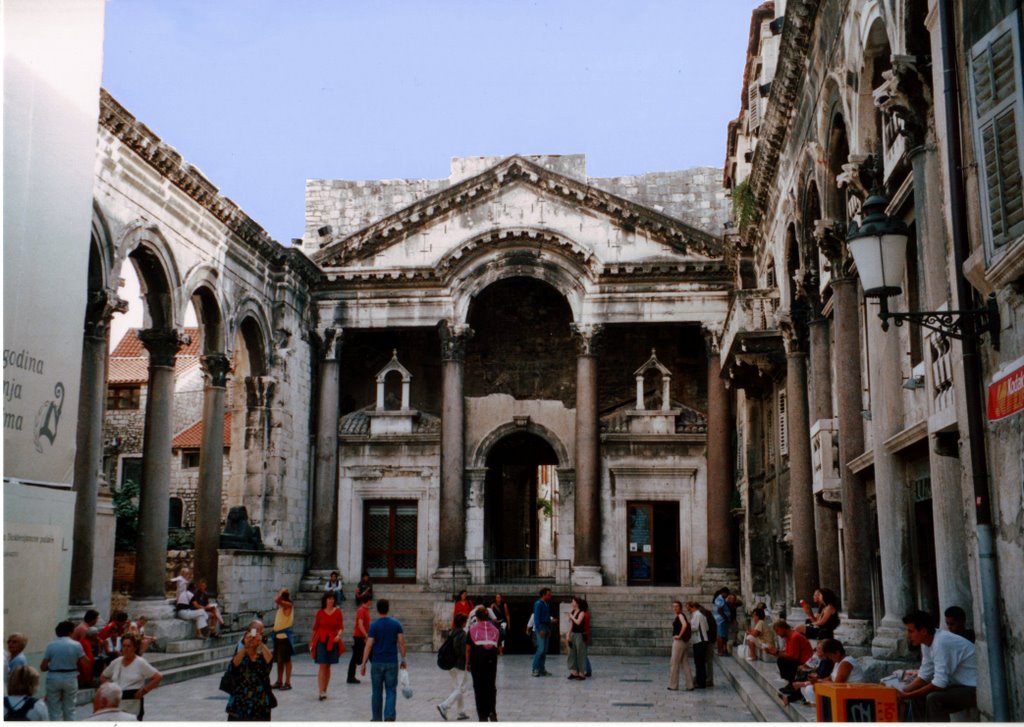Diocletian Palace, From Emperor To Enigma
Few people are so central to the history of Split as the third-century Roman Emperor Diocletian (245-311). And yet it is surprising how little we know about the man. The narratives routinely trotted out by tourist publications are frequently based on a consensus of suppositions rather than hard facts. With new interpretations emerging in the wake of every archeological discovery, however, the sands of historical record are constantly shifting.
Diocletian's status as founder of the city is celebrated every year in the Days of Diocletian, when locals dressed as Diocletian and his retinue arrive by chariot to greet the crowds. Putting his three-day toga-party aside, however, there's a surprising lack of a commercialized Diocletian cult in Split. If you're looking for a Diocletian T-shirt, an imperial signet ring, or even a decent biography of Diocletian written in plain language and with nice pictures, you'll be going home empty-handed. Diocletian is thought to have been born to humble parents in or near the city of Salona (next to present-day Solin just inland from Split), rising through the ranks of the army before being proclaimed as Roman Emperor in 284. He reformed the Roman Empire by establishing the Tetrarchy (basically rule by four - a system of divided sovereighnty in which there were two emperors and two vice-emperors), then abdicated in 305, returning to the land of his birth. The retirement palace he built on the Adriatic shore became the founding structure of present-day Split, its walled precincts re-used, adapted or plundered for their stone by subsequent generations, creating the core of the modern city.
We know a lot about Diocletian's military victories and governmental reforms because they are described in detail by near-contemporary sources. The personal biography of the man is a much mistier affair - we can't say with any certainty where he was born, why he retired, or precisely how big his palace settlement actually was. Wandering around the palace precinct today, Diocletian's heritage is ever present, but the man remains elusive.
The fact that the former palace area now forms the heart of a living city means that it is not a traditional archeological site with everything labeled for the visitor, making it difficult to extrapolate much about how Diocletian lived. Things are compounded by the fact that none of Split's museums provide a detailed picture of Diocletan's era, and the visitor really has to tour the palace area, visit the City Museum and then trek out to the Archeological Museum in an attempt to piece together a picture of what third - and fourth-century Split was actually like.
It's because the palace precinct remains a residential area that it's unlikely that archeologists will ever be able to examine it in its entirety. The best opportunity to discover more about Diocletan's life and times came in the 1950s with the clearing of the palace basement, a substructure in the southern part of the palace precinct which is thought to mirror exactly the floor plan of the imperial apartments that once stood above. The reason why a basement exists beneath this part of the palace is believed to be because the ground beneath Diocletian's planned living quarters dropped sharply towards the sea, so a set of foundations had to be built in order to raise the level of the ground floor.

The basement has since served as a film set for several scenes of the HBO series Game of Thrones; what it was used for during Diocletan's time remains the subject of much conjecture. It was almost certainly used as a living space by the squatters who took over the palace following the fall of Salona in the seventh century. Once they moved up to ground level and started building their own dwellings from the palace masonry, the basement became a huge waste bin and shit hole, fed by the primitive toilets and inadequate drainage channels of the tenements above. When the petrified shit of medieval Split was finally cleared out of the basement by post-war archeologists, several tantalizing lefovers of the Diocletian era were revealed. A fragment of a porphyry sarcophagus, possibly Dioclitian's own, is nowadays on display in the lapidarium of the Archeology Museum. The City Museum displays a large menza or marble food table from which the emperor himself may once have eaten.
The popular view that Diocletian was a true-born Dalmatian who came home is plausible, if not exactly watertight. Diocletian's original name, Diokles, is Greek, so he could have been born anywhere with a bit of Hellenic heritage: multiracial, multilingual Salona certainly can't be ruled out. Contemporary writer Lactantius, who was a civil servant under Diocletian, tells us that the emperor, upon his abdication, left the imperial capital Nicomedia like an old soldier 'dismissed into his own country', suggesting that the old man was going back to where he was born.
However there were many other reasons why Diocletian may have chosen to build his palace here - access to sulphurous springs, proximity to a big city like Salona, and most crucially, good maritime links and ease of seaborne escape. Construction on the palace began at least ten years before Diocletian's abdication, which may indicate that it was initially envisaged as the seat of a ruling emperor rather than the retirement villa of a homesick pensioner. Diocletian didn't just reform the administration of the empire, he also reformed the ceremonial that surrounded the imperial court. The Emperor was henceforth considered a god from the moment of his accession, and people had to abase themselves when introduced into his presence. The desire to build fabulous palaces was an outgrowth of this new culture of adoration, and the palace at Split was by no means the only one that Diocletian built. Diocletian wanted his imperial captial at Nicomedia to rival Rome, and large parts of the city were demolished to make way for his official residence. He also built a fortified palace in Antioch which, although no longer in existence, is thought to have resembled the one in Split.
It's also an open question whether Diocletian's palace really was just a palace, or a part of an already exisitng settlement. The name Split derrives from the Latin Spalatum, which in turn is a corruption of the greek Aspalathos (which really means hairy broom, the wiry, yellow-flowered plant that covers this stretch of the coast), and it is assumed that the Greeks got here before Diocletian did. Stone fragments of a well found at the entrance of the palace basement predate Diocletian's time by several centuries. The recent renovation of the Split waterfront revealed wooden beams which confirmed the existence of a port here in the pre-Roman era. It's entirely possible that Diocletian demolished parts of an existing settlement in order to make room for his palace, much in the same manner as Romanian dictator Nicolae Ceausescu, who cleared large parts of downtown Bucharest to make way for the brand-new Centru Civic in the 1980s.
Although we know a great deal about the shape and function of Diocletian's palace (imperial apartments in the south, accomodation for guards and servants in the north), the question of what lay immediately outside the palace walls remains the subject of much fervant debate. Recent excavations have suggested the existence of a hppodrome just outside the palace, and an amphitheatre (or at the very least a theatre) just inland. This might mean that the palace was not just an imperial retirement home but a much bigger settlement comprising entertainment facilities: 'some kind of Roman-era Las Vegas', the Croation magazine Globus suggested in April 2014. The idea that Diocletian's Split was a resort seems to be a backward projection of our present-day preoccupation with the travel and entertainment industries. However it's certainly plausible that Diocletian's settlement was more than just a palace and served a wider purpose. It is possible that the retired emperor was still an important player on the imperial chessboard, making his palace a political centre to keep the old man out of the way.
Ultimately there's a huge amount of ambiguity about Diocletian's role as local hero or imperial villain. Sure, he built a palace here, but he also presided over the last, greatest persecution of Christians in the annals of imperial Rome. And in a solidly Catholic city like Split, Diocletian's heritage can never be regarded as something entirely positive. The patron saint of the city is after all St. Domnius (Sveti Dujami), the third-century bishop of Salona who was decapitated in the city's amphitheatre on Diocletian's orders in 304AD. St. Domnius's feast day is marked on May 7th with church processions and a city-wide fair - an annual celebration of the fact that Diocletian did not end up on the winning side.
In a very real sense central Split is both a monument to Diocletian and also a solemn shrine to those he had executed. The early-medieval Christian civilization that took over Diocletian's palace engaged in a deliberate attempt to demonstrate its mastery over the emperor's pagan heritage. Diocletian's mausoleum became the Cathedral of St. Domnius. One of the cathedral's most famous altars (carved by Croatian Renaissance master Juraj Dalmatinac) honours St. Anastasius the Fuller, a Salona Christian who was thrown into the sea with a stone around his neck. The crypt of the cathedral, formerly a shrine to Mithras, was rededicated to another of Diocletian's martyrs, St. Lucy. Diocletian's sarcophagus, which once rested in the mausoleum, is assumed to have been thrown into the growing shit pile in the palace basement.
Diocletian shares the fate of many Roman emperors in the sense that there are so few reliable likenesses of him that we can't really be sure what he looked like. Busts of Diocletian may well have been destroyed because of his status as a persecutor of Christians, and the only surviving likeness we can be sure of is a head of Diocletian belonging to the Istanbul Archeological Museum. It shows a bearded, rugged, resolute man, and rather like the images of emperors that appear on coins, it may well be a stock representation of imperial power rather than a genuine portrait. Ultimately the most iconically recognizable character to emerge from Diocletian's palace is not the emperor himself but the granite sphinx that crouches on the balustrade beside the cathedral. One of the several that Diocletian had imported from Egypt, this is the only sphinx that survived in its complete form. Early Christians beheaded all of the others, as if the best way to get at the dead emperor was by decapitating his stone pets. For an emperor like Diocletian, a historical riddle remains unanswered, maybe the sphinx is the most appropriate symbol of all.

This has been reproduced by kind permission from the website Split In Your Pocket.
Johnatan Bousfield, Diocletian, From Emperor To Enigma, Split In Your Pocket, Autumn 2015
